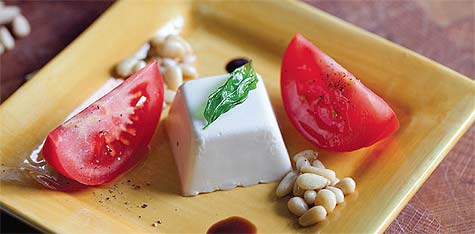
photo by Kelly Yandell
Chef Curt Sassak, The Turtle Restaurant in Brownwood
Serves 6-8
If you love the summery combination of tomatoes and cheese, you’ll appreciate this alternative to the traditional mozzarella and tomato salad.
Panna Cotta (prepare ahead of time)
1 envelope of gelatin granules
1 ½ cups heavy cream, divided use
Salt, to taste
5 ounces goat cheese
Basil Oil
1 cup packed basil leaves
½ cup grape seed oil (or light salad oil)
Pine Nut Garnish
¼ cup toasted pine nuts, chopped or whole
½ clove of garlic, finely minced
1-2 teaspoons olive oil (just enough to coat pine nuts)
Salt
Freshly cracked black pepper
Other Garnishes
3 to 4 ripe tomatoes (½ tomato per serving)
Balsamic vinegar
Salt
Freshly cracked black pepper
Fresh basil leaves for garnish
Pour the gelatin granules in a small bowl which contains ½ cup of heavy cream. Allow the granules to sit in the cream for 5 minutes. Meanwhile, pour the remaining cup of cream into a small saucepan and begin to warm it over low heat. When the cream is warm, add the goat cheese in chunks and allow the goat cheese to slowly melt into the cream. Take care to not overheat or boil the cheese and cream mixture.
When the goat cheese has melted completely into the cream, add in the ½ cup cream containing the gelatin. Again, slowly warm the mixture until all the gelatin has melted into the cream. Test the mixture by inspecting spoonfuls of the cream to ensure that all of the granules have disappeared.
Prepare 6 to 8 small containers (timbale molds, espresso cups or dipping bowls) by spraying them thoroughly with non-stick cooking spray or wiping them with olive oil.
Carefully divide the warm cheese mixture between the containers. Place them on a flat tray and move them to the refrigerator to set for at least 4 hours and preferably overnight.
Your yield will depend on the size of the containers you choose. Take care to choose containers with sloped sides for ease of removal.
For the basil infused oil, heat the ½ cup of grape seed oil in a small saucepan. When the oil is hot, though not smoking, add the basil leaves and submerge them in the oil.
You may hear a crackling noise. Cook for approximately 2 minutes and then remove from the heat. Pour the oil through a sieve and into a heat-proof container. Press the basil leaves in the sieve with the back of a spoon to extract any remaining oil.
For the pine nut garnish, mix together the pine nuts, salt, freshly cracked black pepper and the minced garlic. Add just enough olive oil to coat the nuts and mix to combine.
To assemble the dish, remove the panna cotta from the containers onto the serving dishes. Do this by gently moving the panna cotta away from the edges of the container with your fingers. If it doesn’t readily unmold, you may set the dish in a shallow bowl of warm water for a moment, and then invert it on the serving plate. This may take a little tapping, but do not leave the cups in the water too long or the cheese mixture will begin to melt.
For each dish, arrange tomato slices around the panna cotta. Drizzle the infused basil oil on the tomatoes and season them with salt and pepper. Place drips of balsamic around (but not on) the panna cotta. Finally, garnish the panna cotta with fresh basil leaves.
Curt Sassak is Chef at The Turtle Restaurant in Brownwood.
-
This author does not have any more posts.











